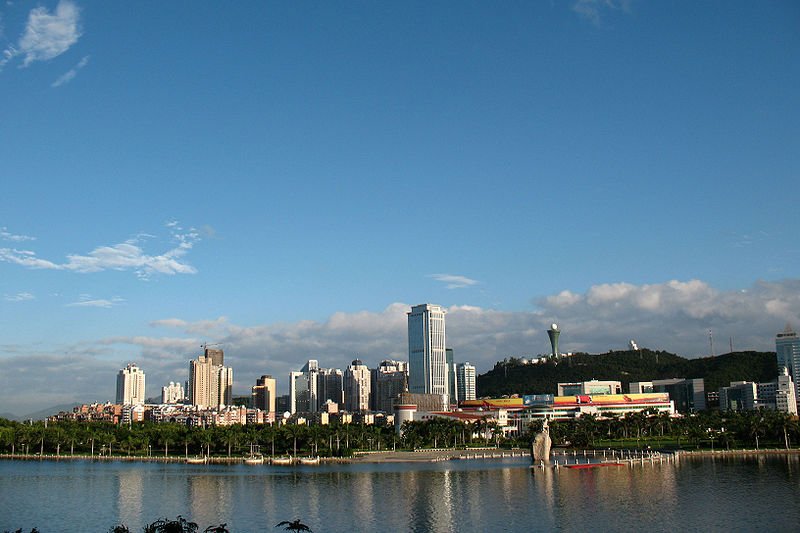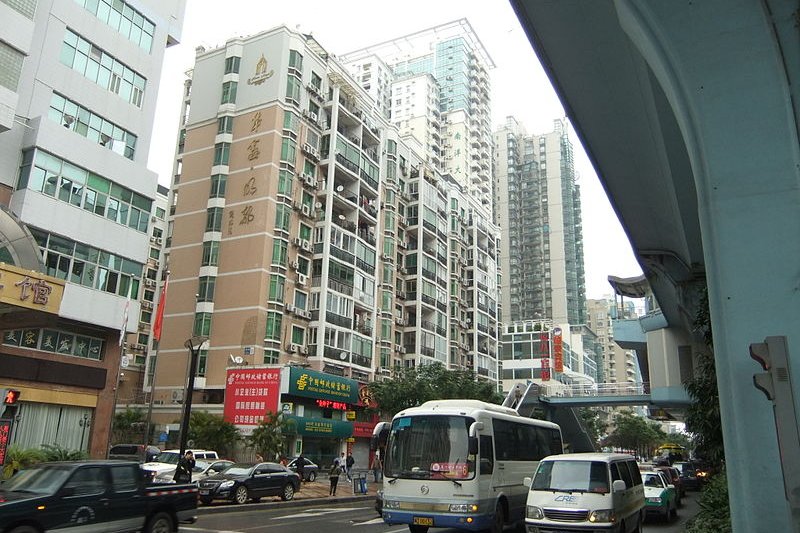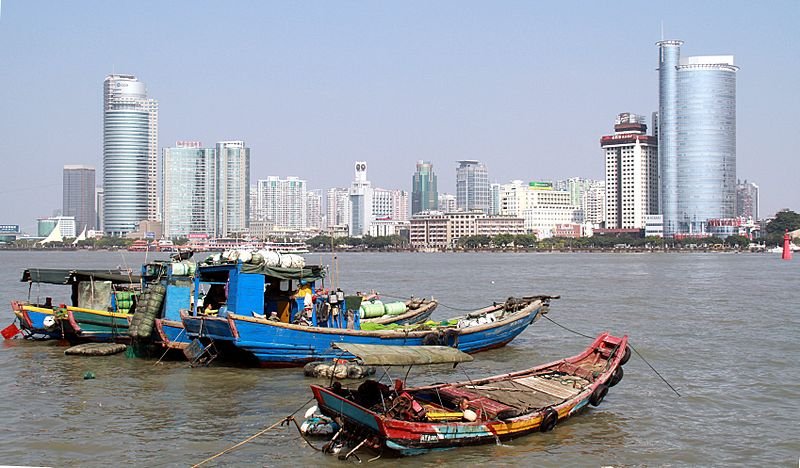 View of Xiamen, looking from south of Yundang Lake
View of Xiamen, looking from south of Yundang LakeSource: https://commons.wikimedia.org/wiki/File:Yundang_Lake.jpg
Author: Xmhaoyu

Xiamen (厦门) is the provincial capital of Fujian Province in southern China. It is one of the cities closest to Taiwan across the strait. Xiamen covers an area of 1565 square kilometers, and has a population of 2.5 million people. The city has prospered in the past few decades as a major manufacturing base. It is one of the four Special Economic Zones of China.
The history of Xiamen goes back to at least the Jin Dynasty, when it was called Tong'an District. By the Song Dynasty, it was already an international port. It was name Siming by Koxinga in 1650, but the Manchu government changed it to Xiamen Subprefecture in 1680. It reverted to Siming in 1912 before reverting again to Xiamen City.
Xiamen was one of the first Chinese ports that had contact with Western powers, beginning with the Portuguese in 1541. The local dialect, Hokkien, also called the Amoy dialect, had a big influence on many of the words used in English today, with many words of Hokkien origin penetrating the language, among them tea (teh), cumshaw (kamsiah), Japan (jit-pun), and so on.
 Downtown Xiamen
Downtown Xiamen
Author: Xmhaoyu

Xiamen (厦门) is the provincial capital of Fujian Province in southern China. It is one of the cities closest to Taiwan across the strait. Xiamen covers an area of 1565 square kilometers, and has a population of 2.5 million people. The city has prospered in the past few decades as a major manufacturing base. It is one of the four Special Economic Zones of China.
The history of Xiamen goes back to at least the Jin Dynasty, when it was called Tong'an District. By the Song Dynasty, it was already an international port. It was name Siming by Koxinga in 1650, but the Manchu government changed it to Xiamen Subprefecture in 1680. It reverted to Siming in 1912 before reverting again to Xiamen City.
Xiamen was one of the first Chinese ports that had contact with Western powers, beginning with the Portuguese in 1541. The local dialect, Hokkien, also called the Amoy dialect, had a big influence on many of the words used in English today, with many words of Hokkien origin penetrating the language, among them tea (teh), cumshaw (kamsiah), Japan (jit-pun), and so on.
 Downtown Xiamen
Downtown XiamenSource: https://commons.wikimedia.org/wiki/File:Xiamen_-_Xiahe_Rd_-_DSCF9299.JPG
Author: Vmenkov

Today Xiamen's economic is based on manufacturing, food processing, textile, telecommunications and financial products. The city benefits from its proximity to Hong Kong and Taiwan.
It only takes 20 minutes by taxi to reach downtown. The fare is ¥8 for the first 3 km and ¥2 for every kilometer thereafter. There's a 50% surcharge for journeys exceeding 8 km. The Airport Shuttle Bus makes the same journey for ¥6 per person.
There are also public buses between the airport and different parts of Xiamen. Bus No. 27 goes to the ferry station, No. 37 to the railway station and No. 91 to the exhibition center.
 Xiamen, Fujian Province
Xiamen, Fujian Province
Author: Vmenkov

Today Xiamen's economic is based on manufacturing, food processing, textile, telecommunications and financial products. The city benefits from its proximity to Hong Kong and Taiwan.
Planning your trip to Xiamen
The Xiamen Gaoqi International Airport (XMN) is located on Xiamen Island. It receives direct scheduled flights from a number of regional cities including Kuala Lumpur, Singapore, Bangkok, Tokyo and Seoul, in addition to all the major cities in China.It only takes 20 minutes by taxi to reach downtown. The fare is ¥8 for the first 3 km and ¥2 for every kilometer thereafter. There's a 50% surcharge for journeys exceeding 8 km. The Airport Shuttle Bus makes the same journey for ¥6 per person.
There are also public buses between the airport and different parts of Xiamen. Bus No. 27 goes to the ferry station, No. 37 to the railway station and No. 91 to the exhibition center.
 Xiamen, Fujian Province
Xiamen, Fujian ProvinceSource: https://commons.wikimedia.org/wiki/File:Gulangyu_xiamen_skyline_2011_12.jpg
Author: Rolfmueller

Looking for information on Penang? Use this Map of Roads in Penang to zoom in on information about Penang, brought to you road by road.

Author: Rolfmueller

Exploring Xiamen
The most practical way to go anywhere is to take the taxi, which is quite cheap at ¥8 for the first 3 km and ¥2 for every kilometer thereafter. The bus service in Xiamen is also excellent, but unless you are a commuter rather than tourist, it takes a bit to learn which bus to take. Another way to explore Xiamen is to join a local tour.Places of Interest in Xiamen
- Nan Putuo Si
Major temple in the southern Chinese style with various halls to different deities. - Huxiyan (Tiger Stream Rock)
A small tempole perched on a high rocky outcrop with fine view of the city. - Wanshi Botanical Garden
Garden with some 4,000 species of plants from South China and Southeast Asia. - Overseas Chinese Museum
Museum that chronicles the history of Fujianese emigration and showcases items belonging to non-resident Chinese. - Huli Shan Paotai
Cannon in Huli Shan Fort. - Jimei School Village
School set in a scenic park. - Gulang Yu
Island off Xiamen with several attractions of its own. - Xiamen Seaworld
Aquarium in Gulang Yu. - Statue of Koxinga
Local warrior who fought against the Manchus. - Shuzhuang Garden
Private villa now a public park with many types of tropical plants. - Gangzaihou Beach
Popular beach on Gulang Yu. - Sunlight Rock
The highest point on Gulang Yu. - Koxinga Memorial Hall
Hall displaying some of Koxinga's personal memorabilia.
 Latest updates on Penang Travel Tips
Latest updates on Penang Travel Tips
 Map of Roads in Penang
Map of Roads in Penang
Looking for information on Penang? Use this Map of Roads in Penang to zoom in on information about Penang, brought to you road by road.
Copyright © 2003-2025 Timothy Tye. All Rights Reserved.

 Go Back
Go Back